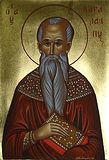

| Previous day | Next day |
| Old Style
February 10
|
Saturday |
New Style
February 23
|
| Fast-free Week. Tone 5. | No fast.
|
![]() Hieromartyr Charalampus, bishop of Magnesia in Asia Minor, and Martyrs Porphyrius and Baptus (202).
Hieromartyr Charalampus, bishop of Magnesia in Asia Minor, and Martyrs Porphyrius and Baptus (202).
Martyrs Ennatha, Valentina, and Paula, of Palestine (308). St. Anna of Novgorod (1050). St. Prochorus of the Kiev Caves (1107). St. Longinus, founder of Koryazhemka Monastery (Vologda) (1540). St. Raphael, archimandrite (1765), and St. Ioannicius, hieromonk (1882), of Svatogorsk Monastery. Synaxis of Novgorod Hierarchs: Sts. Joachim (1030), Luke the Jew (1060), Germanus (1095), Arcadius (1162), Gregory (1193), Martyrius (1199), Anthony (1231), Basil (1352), Moses (1362), Symeon (1421), Gennadius (1504), Pimen (1571), and Athonius (1653).
“Areovindus” (“Fiery Vision”) Icon of the Most Holy Theotokos.
St. Scholastica of Italy (543), sister of St. Benedict of Nursia. St. Anastasius II, patriarch of Jerusalem (706). St. John Chimchimeli of Bachkovo and Gremi (13th c.).
Thoughts for Each Day of the Year
According to the Daily Church Readings from the Word of God
By St. Theophan the Recluse

310
Saturday. [II Tim. 3:1–9; Luke 20:45–21:4]
Who are those having a form of godliness, but denying the power thereof? (II Tim. 3–5). Who are those others, ever learning, and never able to come to the knowledge of the truth? (II Tim. 3:7). The former are those who maintain all the external routines in which a godly life is manifested, but who do not have a strong enough will to maintain their inner dispositions as true godliness demands. They go to church and stand there readily. But they do not make the effort to stand with their mind before God continuously and to reverently fall down before Him. Having prayed a bit, they release the reins of the control of their mind; and it soars, circling over the entire world. As a result, they are externally located in church, but by their inner state they are not there: only the form of godliness remains in them, while its power is not there. You must think about everything else in this manner.
The latter are those who, having entered the realm of faith, do nothing but invent questions—“What is this? What is that? Why this way? Why that way?” They are people suffering from empty inquisitiveness. They do not chase after the truth, only ask and ask. And having found the answer to their questions, they do not dwell on them for long, but soon feel the necessity to look for another answer. And so they whirl about day and night, questioning and questioning, and never fully satisfied with what they learn. Some people chase after pleasures, but these chase after the satisfaction of their inquisitiveness.
Articles
 Hieromartyr Charalampus (Haralambos) the Bishop of Magnesia in ThessalyDespite the bishop’s advanced age (he was 113 years old), he was subjected to monstrous tortures. |
 Martyr Porphyrius in ThessalySaint Porphyrius was a soldier who suffered martyrdom with Saints Charalampus, Bishop of Magnesia, |
 Martyr Baptus in ThessalySaint Baptus was a soldier who suffered martyrdom with Saints Charalampus, Bishop of Magnesia, Porphyrius, and three women in the year 202. |
 Martyrs Ennatha, Valentina, and Paula, of PalestineThe Holy Virgin Martyrs Ennatha, Valentina and Paula suffered in the year 308 under the emperor Maximian II Galerius (305-311). |
 Icon of the Mother of God “Areovindus”The origins of this unusual icon, in which the Most Holy Theotokos is depicted without Christ, are unknown. |





